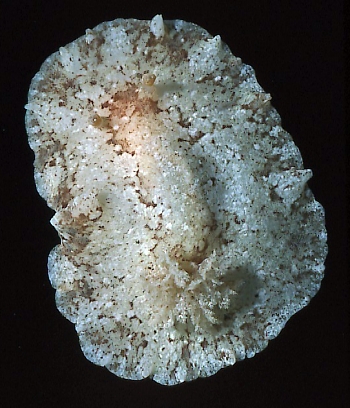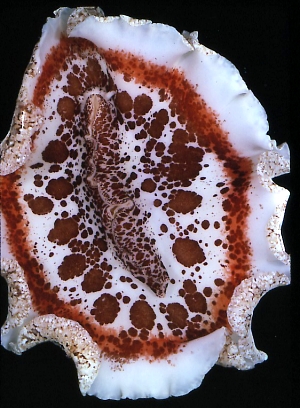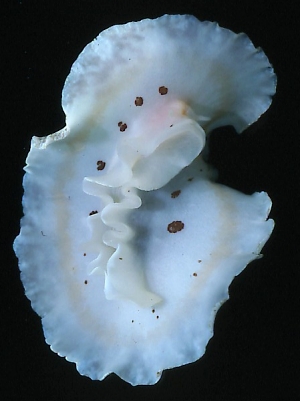Platydoris inframaculata from New Caledonia
July 2, 2007
From: Bill Rudman

In a recent revision (Dorgan et al, 2006) of the genus Platydoris, this large dorid, with a rather nondescript dorsal colour pattern of mottled white, pink and browns is identified as Platydoris inframaculata (Abraham, 1877). I have encountered this dorid in both East Africa and the Western Pacific and had been unable to satisfactorily identify it with any published name. As Dorgan et al note, its most distinctive external feature is the bright white underside with a spectacular pattern of red splashes on the underside of the mantle and the sides of the foot, and a yellow or orange ring running round the mantle about midway out. What is surprising is that Abraham's 1877 paper is a classic example of a museum curator gone mad. He essentially named every preserved unlabelled nudibranch specimen in the collection of the Natural History Museum, London, despite knowing nothing about their living shape or colour. Although many of his names have been used, such as Archidoris wellingtonensis, because there is only one species looking like it in New Zealand, that is not the case of a preserved decolourised Platydoris. Abraham mentions brown spots of different sizes being present ventrally, but as a number of species of Platydoris have brown spots ventrally, it seems risky to use Abraham's name. Also, as I illustrate here, this 'distinctive' colour pattern is not always present.
In many specimens the ventral side of the mantle is brilliantly coloured white with large and smaller red spots scattered over the inner half. More small red spots form a band around the mantle about halfway out. This band is overlain with a broad band of orange. In some specimens, however, the red and orange ventral colour pattern is replaced by an aggregation of dark brown spots on the inner half of the mantle. Usually there is a faint trace of the yellow-orange band [lower left photo], but in some specimens it is almost impossible to see. While the red and orange colour pattern would probably be recognisable in earlier descriptions - especially if the outer ring of small red spots is present, it is not possible to determine if one or more of the many early descriptions of mottled brown dorids, applies to the colour form of this species which only has brown spots ventrally.
In New Caledonia it is associated with, and well-camouflaged on, soft sandy substrates and a specimen from Tanzania (personal observation) half-buried in sand in an aquaria. The species Eliot (1904) reported from Kenya as Platydoris ellioti? (A. & H.) has a ventral colour pattern with brown spots and an orange band. It is clearly this species and not Platydoris ellioti (Alder & Hancock) . It is possible that the species reported by Pruvot-Fol (1954) from Hikuera, as Austrodoris ellioti, is also this species. I follow Dorgan et al in identifying this as P. inframaculata, but have great doubts on whether we can ever be sure.
Upper right; Lower left: Passe du Baron, off Koumac, New Caledonia, 20°33.7'S, 164°10.3'E, 12m, In lagoon, sand with Heteropsammia, 14 October 1993, 63 mm long alive, AM C200480. Lower right: S of Île Rédika, (S Lagoon), 23 m, 18 October 1988, in coral sand patch with Halimeda and Caulerpa, coll: P.Laboute, AM C156645. Photos: Bill Rudman.
-
Abraham, P.S. (1877). Revision of the Anthobranchiate nudibranchiate mollusca, with descriptions or notices of forty-one hitherto undescribed species. Proc. Zool. Soc. London, 1877: 196-269.
-
Alder, J. and Hancock, A. (1864) Notice of a collection of nudibranchiate mollusca made in India by Walter Elliot Esq., with descriptions of several new genera and species. Transactions of the Zoological Society of London 5: 113-147.
-
K.M. Dorgan, A. Valdes and T.M. Gosliner. (2002) Phylogenetic systematics of the genus Platydoris (Mollusca, Nudibranchia, Doridoidea) with descriptions of six new species. Zoologica Scripta, 31: 271-319.
-
Eliot, C.N.E. (1904) On some nudibranchs from East Africa and Zanzibar. Part III. Dorididae Cryptobranchiatae, I. Proceedings of the Zoological Society of London, 1903(2): 354-385, Pls.32-34.
-
Pruvot-Fol, A. (1954) Etude d'une petite collection d'opisthobranches d'Oceanie francaise. Journal de Conchyliologie, 94(1): 3-30.
Bill Rudman


Related messages
-
Re: Platydoris inframaculata from Reunion Island
From: Gary Cobb, August 8, 2008 -
Platydoris inframaculata from Reunion Island
From: Hugues Flodrops, August 5, 2008 -
Platydorid from Lembeh St, Indonesia
From: Heidi Hösel, April 22, 2008 -
Re: Platydoris inframaculata from New Caledonia
From: Gary Cobb, April 17, 2008 -
Platydoris inframaculata from the Red Sea
From: Ing. Harald Sapper, July 2, 2007
